It was late September, and the salmon run was nearing its end. Heavy rains lashed the southern borders of the Great Bear Rainforest. I had made the trip to the remote region of British Colombia, Canada in search of Grizzly bears
The swollen river was spewing the last of her salmon bounty into the estuary. This is where opportunistic Bald Eagles gathered to take advantage of the protein-rich fuel before the onset of winter.

The first eagles that I encountered were the young, first-year birds. These birds didn’t need to waste energy on learning how to fish. The river was giving up fresh salmon carcasses with no effort required. This was the start of an education for me, as I hadn’t realized how the colour phases of the Bald eagle change with age. The first-year bird is uniform brown all over. It is at least as big, if not bigger than the adult, due to the thick downy feathers of youth beneath the chocolate overcoat. As the boat passed by a young eagle perched on a raised bank, I found myself eye to eye with this beautiful bird with fierce, chestnut eyes.
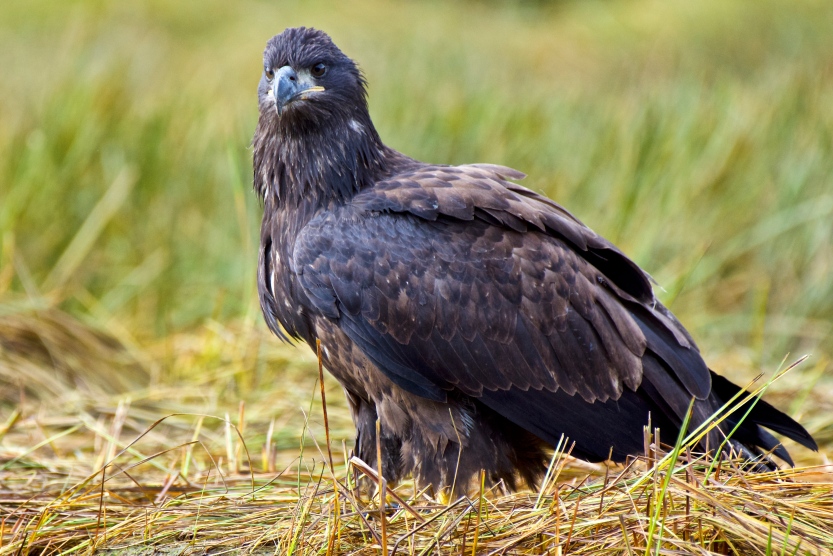
We moved a little further upstream and now my challenge became clear. I am immersed in a bucket-list experience of being in the presence of wild Grizzly bears, while at the same time another North American icon, the Bald eagle circled overhead. Where to point the camera! The answer was clear; move fast, point the camera at both. Don’t miss Grizzly behaviour for an eagle, try not to miss an eagle opportunity if the bear is at rest.
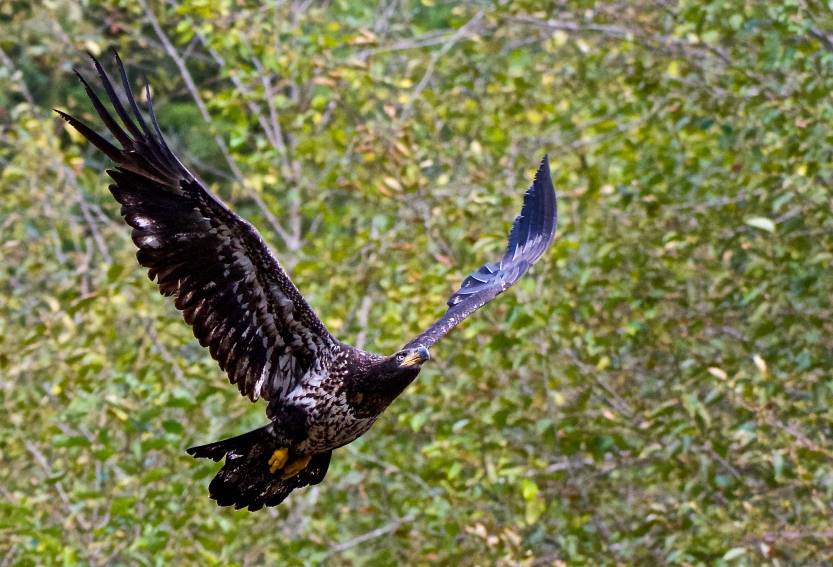
The trees opened up to white clouds, and an eagle moved into clear air above the river channel. The eagle missiled towards the boat before raising its beak upwards to land on a high branch. I fired off some shots, capturing the second-year bird spreading its wings into a graceful landing. I love these second-year birds. Now the eagle is wearing its characteristic yellow feet, while the body is almost a negative of the adult. The white ‘Bald’ head appears chocolate-dipped and the brown body is mottled white and brown. The chestnut eye is now buttery yellow.

A third-year bird circled into view. This curious bird looped around the boat a couple of times, no doubt checking for a free meal. At year three, the body is now brown, but not the rich brown of the adults. The head is transforming, but has a silver-grey look. The tail feathers are also coming through in the same silver grey.

An adult eagle glides overhead. Now the eagle is transformed. The body is rich brown and the white head is sharp, and regal, with tail to match. The talons and beak flash like golden blades in the shadow of the trees.
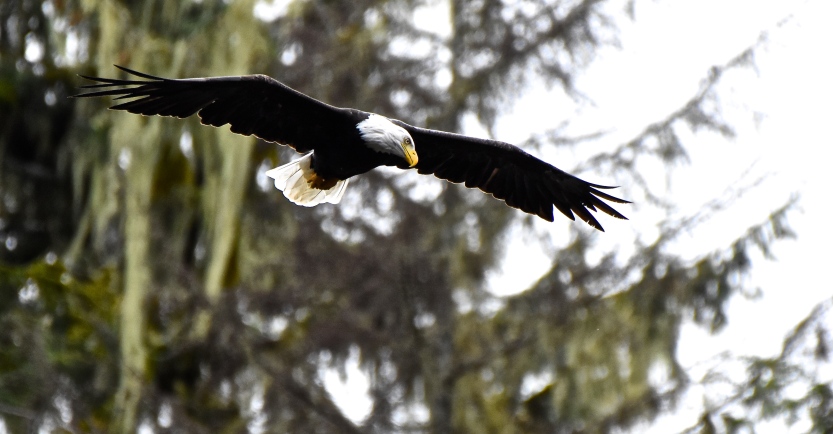
The Bald eagle in flight is a spectacular sight. This is a prodigious bird of prey, growing to 3 feet (91.4 cm) in length with a 7 feet (2.1 meters) wingspan. Weighing in up to an impressive 14 pounds (6.3 Kg) , it is difficult to confuse the eagle with any other bird. In the wild the eagle can survive for around 20 years, although captive specimens have reached closer to 40 years.
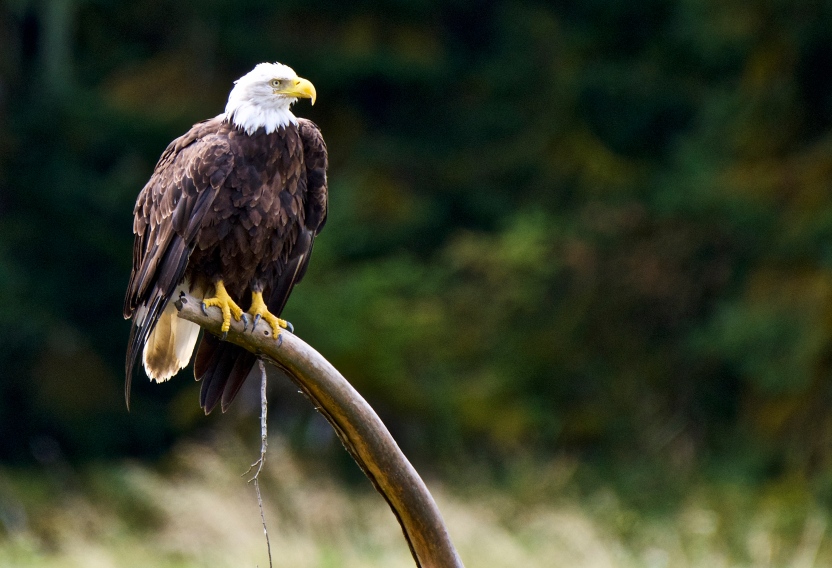
It is surely impossible to be unaware of the existence of the Bald eagle. America’s national bird, and indeed national animal, sits proudly in the centre of The Great Seal of the United States of America. It has been a symbol of strength, and freedom for the mighty super-power since the declaration of independence. Being a national emblem is no guarantee of safety. The Bald eagle was allowed to drift towards extinction, with only 500 nesting pairs left in the lower 48 states. This earned the bird a place on the US Federal Government’s ‘Endangered’ list. Threats to the survival of Bald eagles included hunting, due to a mistaken belief that the birds kill farm animals, and attack children. The main threat, however, was the use of the pesticide DDT, that had such a catastrophic effect on birds of prey such as eagles and the other great fish hunter, the Osprey.
In 1995 conservation efforts were rewarded when the Bald eagle was moved to the status of ‘Threatened’. In 2007 the eagle was removed from the ‘Threatened’ list, and recategorized as ‘Least Concern’. A heart warming success story that shows what can be achieved where there is a presence of real commitment.
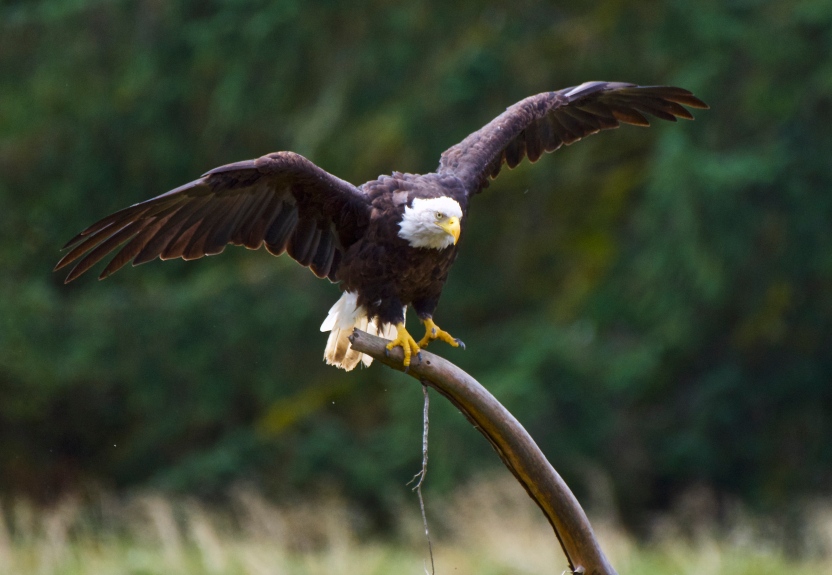
The Bald eagle commands a sacred place in the lives of the indigenous peoples of the Americas. It is believed by many tribes that the eagle, flying higher than any other bird, and possessing unparalleled eyesight, acts as a messenger, carrying prayers between people and the creator, and ancestors. Eagle feathers are used in ceremony to summon the creator, but as we consistently see with indigenous peoples, the collection of these feathers does not result in live birds being harmed.
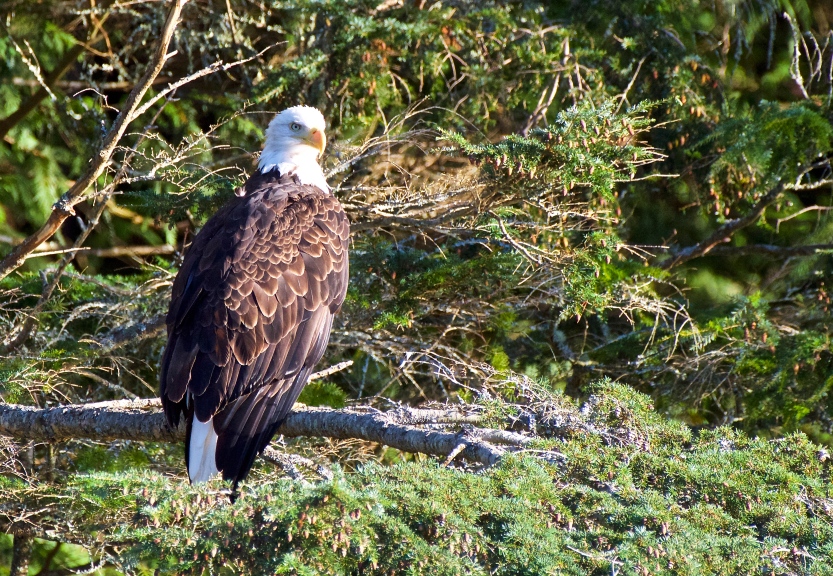
My last Canadian eagle of the trip was bathing in the glow of the evening sun, above a colony of Steller Sea lions, on an island off of Campbell River. This made for a good spot to pick up a scrap from a sea lion hunt or the carcass of a sick animal. A magnificent adult specimen fixed me with its piercing eyes.
The great eagle of the North American continent doesn’t care about its revered status and symbolism in the United States. It cares even less for borders drawn across this immense continent, as it graces the skies from Alaska, through Canada to Mexico. Perhaps the Bald eagle’s most important role in today’s world is as a symbol of what can be achieved when conservation commitment is dignified with action.
Help others to connect with wildlife experiences by sharing this post on social media.
Share your thoughts in the comments section below.
Did you enjoy this post? If so please follow Incidental Naturalist. No spam, just articles.
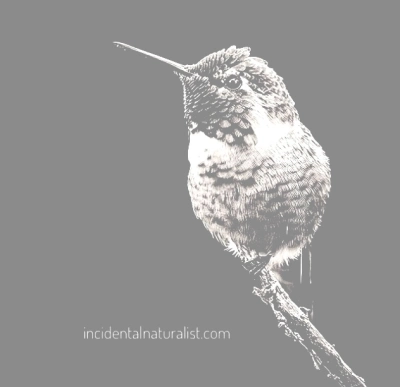


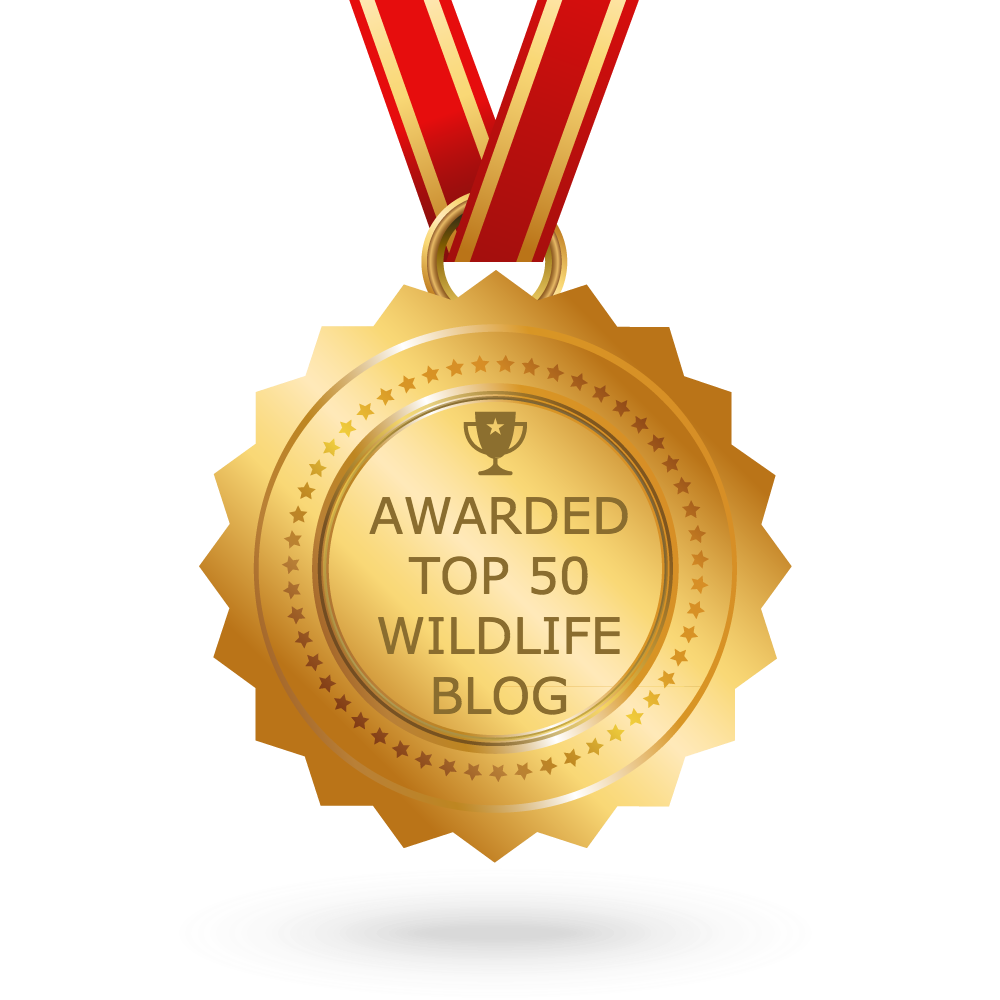

Sounds like you had an awesome trip. I also for your post quite informative with all the different stages of the Eagle….would love to see all those stages. Great post!!
LikeLiked by 1 person
Thank you! Yes, I didn’t realize how the eagle goes through so many different phases. It was a great learning moment for me. Thanks again for the comment!
LikeLiked by 1 person
Beautifully written!
LikeLiked by 1 person
Thank you! 🙂
LikeLike
Stunning Pics.
Ausi | http://www.wanderfulweekendz.com
LikeLiked by 1 person
Thank you!
LikeLike
Interesting post and great pics and a gorgeous bird. Thank you. I particularly like the last paragraph and I also hope that more meaningful conservation actions are inspired by this story. Let’s also hope that animals do not have to be listed as “threatened” before meaningful action takes place.
LikeLiked by 1 person
Thanks for the great comment! It is wonderful to see this marvelous creature removed from the ‘Threatened’ list. There are so many less spectacular creatures that could be re-populated with a similar level of commitment.
LikeLike
All the pics are such great shots, David, but that last one in the sunlight really is my favorite! Thank you for the ongoing education about our natural world, one beautiful animal at a time. And cheers to committed action for conservation – ongoing!
LikeLiked by 1 person
Thank you, Lara for your kind and encouraging words. Always very much appreciated! I’m glad that you enjoyed the piece and found it educational. The more people who get to see what is possible, the better our chances are taking actions to protect the natural world.
LikeLiked by 1 person
Beautifully said, David – one of the many reasons why I like your blog! Thank you for the ongoing education and inspired action =) Cheers!
LikeLiked by 1 person
What a glorious adventure that must have been. Your photos are superb. I look forward to seeing the grizzlies.
Alison
LikeLiked by 1 person
Thank you so much, Alison! Wait not a moment longer! The Grizzlies article has already been published. 🙂 https://incidentalnaturalist.com/2016/11/02/the-grizzlies-of-the-great-bear-rainforest/
LikeLiked by 1 person
I saw my first bald eagle in the Pacific Northwest in the early 90s. Cars were slowing in amazement that it was in a tree by the road for all to see! Now rarely do I have a bike ride where I don’t see at least one either in a tall tree or winging above me! I still stop every time and try for a photo! great post as always!
LikeLiked by 1 person
Thanks Tony! It is a great story, and I don’t think it is possible to get tired of seeing these awesome birds.
LikeLiked by 1 person
Awesome! Really enjoyed the blog – didnt realise they also take advantage of the salmon with the grizzlies.
We in Western Australia also have an endangered state emblem – less than 1000 numbats left..
LikeLiked by 1 person
Thanks for the kind comment! The salmon run really is the engine that drives that NW Pacific coast. I hope you have success with bringing numbat numbers back over in WA. They are fantastic little animals!
LikeLike
A beautiful post with spectacular images of these eagles! Thank you for sharing so much excellent information about our majestic national symbol. Be careful out there in Grizzly territory!!
LikeLiked by 1 person
Thank you for your kind and encouraging comment! Those grizzlies were far more interested in salmon to worry about a strange guy with a camera. ☺
LikeLiked by 1 person
Good to know!
LikeLike
Amazing post on the bald eagle!
LikeLiked by 1 person
Thank you!
LikeLiked by 1 person
Your welcome!
LikeLike
The first time I came face to face with a Bald Eagle was at the raptor rescue and rehab centre in Vermont (VINS). I have been smitten ever since! These birds are magnificent – so beautiful. Can see why they are the US national emblem.
LikeLiked by 1 person
Thanks for the comment! They really are beautiful and awesome close up! The rescue centers do a great job and really help people engage with the eagles.
LikeLike
What a beautifully written article about an incredibly majestic bird. Your photos are spectacular and capture the commanding presence of this bold and beautiful creature. Thank you!
LikeLike
I enjoyed your story. Well written, lovely pictures. I am a huge fan of NA Bald Eagle and particularly the Decorah Eagle Nest in Iowa. They posted you story on the Raptor Resouce Project Facebook page. The nest cam experience is unmatched and I have been watching for seven seasons. We presently have three healthy vibrant babies. Your photography and story telling would be amazing here. I hope you get the opportunity to go there. Thanks for sharing your journey.
LikeLiked by 1 person
Thank you so much, Jeanne! I’m glad you found my blog. Hope you find some other articles on there that you enjoy. I’ve been watching the Raptor Resource web cams. Fantastic resource! Thanks again!
LikeLike
Dave
This is another insightful and interesting article. Keep up the writing!
Cheers
Gareth
LikeLiked by 1 person
Thanks for the encouragement, Gareth! Hope you’re well.
LikeLike
Very informative post!
LikeLiked by 1 person
I just found your blog. Beautiful.
LikeLiked by 1 person
Thank you! 🙏
LikeLike
Silver eagles mus be beautiful…Wonder how many colors there are of the specie?
LikeLiked by 1 person